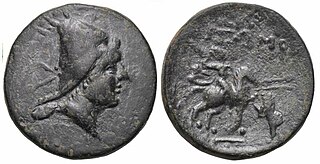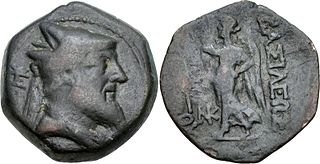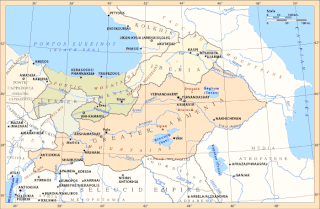Shalmaneser IV was the king of the Neo-Assyrian Empire from 783 BC to his death in 773 BC. Shalmaneser was the son and successor of his predecessor, Adad-nirari III, and ruled during a period of Assyrian decline from which few sources survive. As such his reign, other than broad political developments, is poorly known. Shalmaneser's time was marked both by an increase in the power held by Assyrian officials relative to that of the king and Assyria's enemies growing increasingly powerful. Most of Shalmaneser's military efforts were spent warring against the Kingdom of Urartu in the north, which during this time was reaching the peak of its power.

Antiochus X Eusebes Philopator was a Seleucid monarch who reigned as King of Syria during the Hellenistic period between 95 BC and 92 BC or 89/88 BC. He was the son of Antiochus IX and perhaps his Egyptian wife Cleopatra IV. Eusebes lived during a period of general disintegration in Seleucid Syria, characterized by civil wars, foreign interference by Ptolemaic Egypt and incursions by the Parthians. Antiochus IX was killed in 95 BC at the hands of Seleucus VI, the son of his half-brother and rival Antiochus VIII. Antiochus X then went to the city of Aradus where he declared himself king. He avenged his father by defeating Seleucus VI, who was eventually killed.

Antiochus VIII Epiphanes/Callinicus/Philometor, nicknamed Grypus, was the ruler of the Hellenistic Seleucid Empire from 125 to 96 BC. He was the younger son of Demetrius II and Cleopatra Thea. He may have spent his early life in Athens and returned to Syria after the deaths of his father and brother Seleucus V. At first he was joint ruler with his mother. Fearing her influence, Antiochus VIII had Cleopatra Thea poisoned in 121 BC.

Antiochus I Theos Dikaios Epiphanes Philorhomaios Philhellen was king of the Greco-Iranian kingdom of Commagene and the most famous king of that kingdom.
The Orontid dynasty, also known as the Eruandids or Eruandunis, ruled the Satrapy of Armenia until 330 BC and the Kingdom of Armenia from 321 BC to 200 BC. The Orontids ruled first as client kings or satraps of the Achaemenid Empire and after the collapse of the Achaemenid Empire established an independent kingdom. Later, a branch of the Orontids ruled as kings of Sophene and Commagene. They are the first of the three royal dynasties that successively ruled the antiquity-era Kingdom of Armenia.

Sames I, was the Orontid king of Sophene and Commagene, ruling around 260 BC.

Arsames I seems to have taken control of Commagene, Sophene and Armenia in the year 260 BC after the death of his grandfather Orontes III, king of Armenia, and his father Sames, king of Commagene.

Xerxes was king of Sophene and Commagene from 228 BC to 212 BC. He was the son and successor of Arsames I.

Commagene was an ancient Greco-Iranian kingdom ruled by a Hellenized branch of the Iranian Orontid dynasty that had ruled over Armenia. The kingdom was located in and around the ancient city of Samosata, which served as its capital. The Iron Age name of Samosata, Kummuh, probably gives its name to Commagene.

The Satrapy of Armenia, a region controlled by the Orontid dynasty, was one of the satrapies of the Achaemenid Empire in the 6th century BC that later became an independent kingdom. Its capitals were Tushpa and later Erebuni.
Ptolemaeus was initially the satrap of Commagene, later becoming its first king in 163 BC. He belonged to the Orontid Dynasty, founded by Orontes I. Ptolemaeus' father was King Orontes IV of Armenia, son of Arsames I.
Mithridates I Callinicus was a king of Orontid Iranian descent who lived during the late 2nd century BC and early 1st century BC. Mithridates was a prince, the son, and successor of King of Commagene, Sames II Theosebes Dikaios. Before his succession in 109 BC, he married the Syrian Greek Princess Laodice VII Thea, daughter of King Antiochus VIII Grypus and Ptolemaic princess Tryphaena, as a part of a peace alliance. Mithridates embraced Greek culture. Laodice bore Mithridates a son, Antiochus I Theos of Commagene, a prince and future king of Commagene. Mithridates died in 70 BC and Antiochus succeeded him.
Mithridates III Antiochus Epiphanes was a prince who served as a King of Commagene.
Antiochus III Epiphanes was the ruler of the Kingdom of Commagene from 12 BC to 17 AD. He was the son and successor of King Mithridates III of Commagene and Iotapa, and of mixed Iranian, Armenian, Greek and Median descent – the last through his mother. His parents were first cousins.

Mithridates II Antiochus Epiphanes Philorhomaeus Philhellen Monocrites, also known as Mithridates II of Commagene, was a king of Commagene in the 1st century BC.

The Kingdom of Sophene, was a Hellenistic-era political entity situated between ancient Armenia and Syria. Ruled by the Orontid dynasty, the kingdom was culturally mixed with Greek, Armenian, Iranian, Syrian, Anatolian and Roman influences. Founded around the 3rd century BCE, the kingdom maintained independence until c. 95 BCE when the Artaxiad king Tigranes the Great conquered the territories as part of his empire. Sophene laid near medieval Kharput, which is present day Elazığ.
Antiochus II was a man of Iranian and Greek descent. Antiochus II was a prince from the Kingdom of Commagene and the second son of King Antiochus I Theos of Commagene. He was the youngest brother of prince and future king Mithridates II of Commagene.

Orontes IV was the son of King Arsames and is recorded as ruling Armenia from inscriptions found at the historic capital of the Orontid dynasty, Armavir. He was the founder of the city of Yervandashat. In his reign the religious site of Bagaran was founded. Large bronze statues in the Hellenistic style of the gods, Zeus (Aramazd), Artemis (Anahit) and Herakles (Vahagn) were brought there and set up in temples dedicated to them. He is also said to have founded a shrine at Armavir dedicated to Apollo (Mithra), a golden statue of four horses pulling a chariot with Apollo as god of the Sun. This was later destroyed by the Sassanid Persian army in the 4th century AD.

The timeline of ancient Assyria can be broken down into three main eras: the Old Assyrian period, Middle Assyrian Empire, and Neo-Assyrian Empire. Modern scholars typically also recognize an Early period preceding the Old Assyrian period and a post-imperial period succeeding the Neo-Assyrian period.

The Sargonid dynasty was the final ruling dynasty of Assyria, ruling as kings of Assyria during the Neo-Assyrian Empire for just over a century from the ascent of Sargon II in 722 BC to the fall of Assyria in 609 BC. Although Assyria would ultimately fall during their rule, the Sargonid dynasty ruled the country during the apex of its power and Sargon II's three immediate successors Sennacherib, Esarhaddon and Ashurbanipal are generally regarded as three of the greatest Assyrian monarchs. Though the dynasty encompasses seven Assyrian kings, two vassal kings in Babylonia and numerous princes and princesses, the term Sargonids is sometimes used solely for Sennacherib, Esarhaddon and Ashurbanipal.












